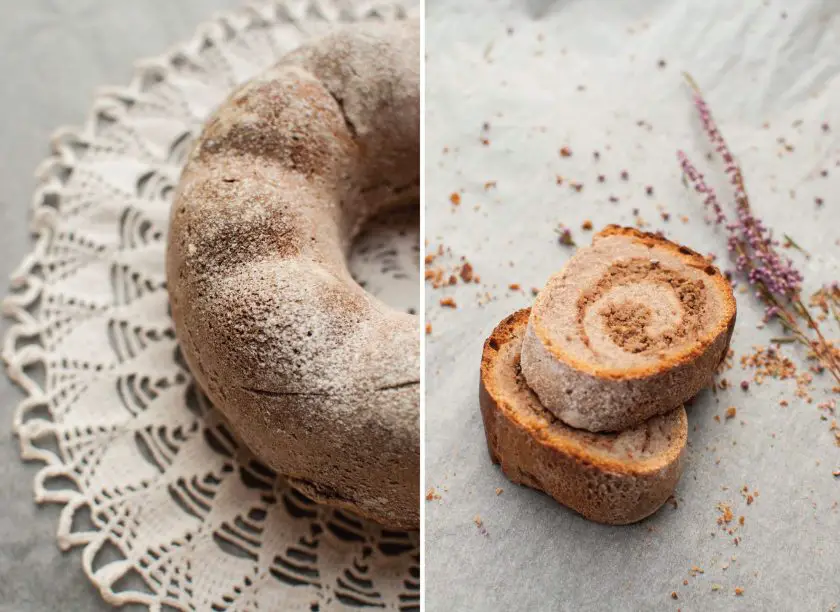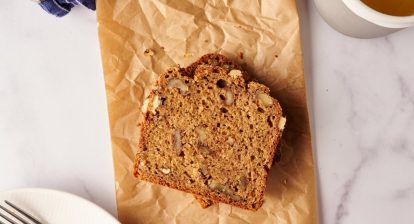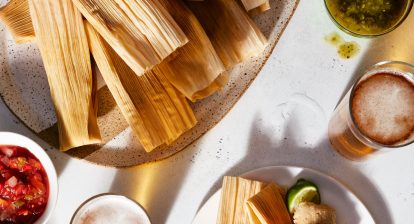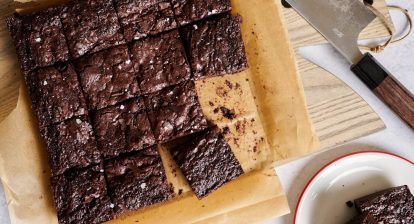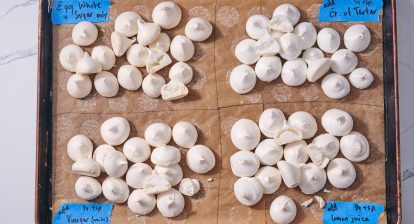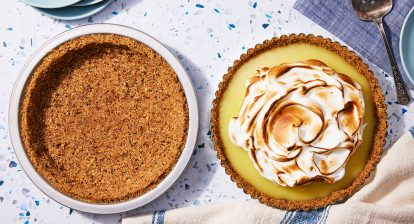Potica brings back many memories. And now I'm sharing with you my recipe for Sourdough Potica, otherwise known as Sourdough Walnut Swirl Bread.

Table of Contents
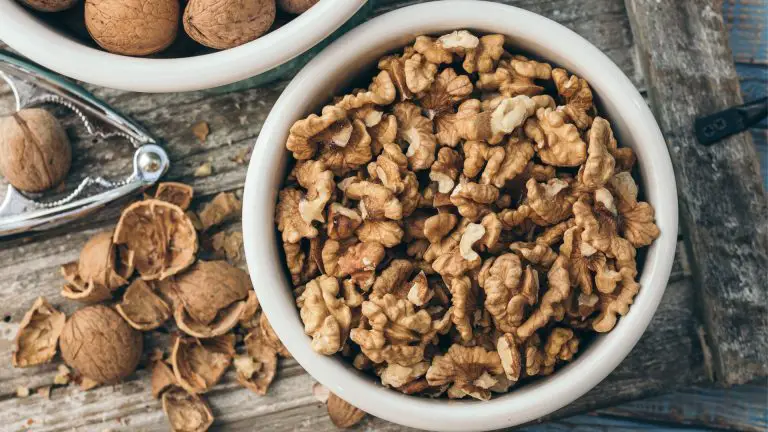
- 225 g white wheat flour
- 150 g active sourdough starter with white wheat flour
- 100 g nut milk (or any milk of your choice)
- 1 tablespoon rum
- 1 tablespoon honey
- 35 g fat
- 4 g fine sea salt
- 150 g ground nuts
- 200 g applesauce
- 1 tablespoon rum
- 1 tablespoon honey
- The night before you make the nut bread, mix 75g white wheat flour, 75g water and 1 tablespoon active sourdough starter. Let it ferment overnight or until it turns brown and rises to the surface
- In the morning, spread the whole starter in the nut milk. Add honey, rum, fat, salt and mix well. Add 225 g of flour and knead the dough until all the ingredients are combined. The dough will be quite soft. You may notice that the dough has a slight purple to gray tone – this is due to the tannins in the nuts. Then knead the dough for another 5 minutes until the dough becomes soft. Transfer it to a clean, slightly greased container and let it rise until it doubles in volume. It took 4.5 hours for my dough to double in size. If you want to speed up the fermentation, you can put the bowl in a slightly warm oven.
- Just before you see your dough double in size, prepare your filling and baking dish. For the filling: mix ground walnuts with warm or cold applesauce, honey and rum. Mix well until you get a smooth paste. If the filling seems dry, add more applesauce to make it more spreadable. To prepare a baking dish, grease it (butter, coconut oil) and sprinkle it with flour.
- When the dough has doubled, use a plastic scraper to take it to a work surface and shape it into a ball. Let it rest for at least 10 minutes so that you can roll it easily as the dough will not shrink.
- Roll out the dough so that it is about half an inch thick (or less if you want to see more swirls in the profile) and is as long as the inside circumference of your baking dish (use a string to measure). Spread the filling to the edges but leave a 2cm strip on one longer side without filling.
- Start rolling the dough tightly at the longer end with the filling. When done, carefully transfer to a baking dish, cut side down, making sure to pinch the edges together.
- Let the dough rise again. My dough took 1.5 hours to fully proof. How will you know that the dough is ready to put in the oven? Make an opening with your finger and observe the reaction – if the indentation returns quickly, let it rise a little more. If it turns slowly, you'll know it's ready to put in the oven.
- At least 10 minutes before baking, preheat your oven to 200°C (392°F) along with the baking pan you have placed on the bottom rack.
- When ready, place the baking dish in the oven, drop ice cubes into the baking pan and close the door. Bake the roll for 15 minutes at 200°C (392°F), 20 minutes at 180°C (356°F) and for another hour at 160°C (320°F). The top crust should be brown, but most importantly make sure the bottom is also cooked. This time the oven played tricks on me, so after an hour I had to take the roll out of the baking dish and then bake it in a baking pan.
- Preparation time: 18 hours
- Cooking time: 35 minutes
- Category: dessert
- Kitchen: European, American
When I was younger, I often asked my mother to make me a loaf of bread with plum jam. It was my ultimate comfort food. I got lost in the velvety texture and enticing aroma of ripe plums and crispy crust burning in the wood stove.
Many years later I know that going into comfort food means listening to my heart's whispers to reality and avoiding questions about how I really feel. I know how I feel. It is spring with all its light, softness and uncertainties that just beg to be acknowledged. However, not with food, but with awareness. That way I can let the baked goods bring out all their hidden beauty unencumbered by my thoughts. Like swirled nutty bread, traces.
Potica (po-TEET-sah) is a typical Slovenian bread with a festive twist that is eaten at Easter and Christmas. It comes in different shapes (round, long) and different fillings (walnut, poppy seeds, tarragonchocolate, coconut, crunchy, carob). Despite the varieties, good potica today is still considered the pride of every housewife.
Sourdough Walnut Roll Bread – potica (po-TEET-sah)
Baking time for this Sourdough Walnut Bread
The sourdough nut roll dough is mixed in the morning, left to rise for 4.5 hours, then rolled and left to rise a second time for another 1.5 hours. The sourdough starter was mixed the night before and left to rise overnight.
If you want to make rolls during the week when you're at work, mix the dough in the morning and then make sure to let the dough rise to room temperature so the dough doubles in size when you get home from work. .
Ingredients for sourdough
yields: 4 perfect servings for 4 people eating sourdough bread with a cup of afternoon tea
- 225 g of white wheat flour
- 150 g active sourdough starter with white wheat flour
- 100 g nut milk (or any other milk of your choice)
- 1 spoon of rum
- 1 spoon of honey (I used acacia honey which has a fairly neutral taste, you can also use floral honey)
- 35 g of fat (I used 12 g of butter and 2 tablespoons of olive oil filled with lemon peel that tastes like a juicy lemon peel :D)
- 4 g fine sea salt
Nut filling ingredients
- 150 g of ground walnuts
- 200 g of applesauce
- 1 spoon of rum
- 1 spoon of honey
Others
- 10 ice cubes for steaming while baking
Instructions on how to make Sourdough Walnut Bread
- The night before you make the nut bread, mix 75g of white wheat flour, 75g of water and 1 tablespoon of active sourdough starter. Let it ferment overnight or until it rises and rises to the surface.
- In the morning, spread the whole starter in the nut milk. Add honey, rum, fat, salt and mix well. Add 225 g of flour and knead the dough until all the ingredients are combined. The dough will be quite soft. You may notice that the dough has a slight purple to gray tone – this is due to the tannins in the nuts. Then knead the dough for another 5 minutes until the dough becomes soft. Transfer it to a clean, slightly greased container and let it rise until it doubles in volume. It took 4.5 hours for my dough to double in size. If you want to speed up the fermentation, you can put the bowl in a slightly warm oven.

- Just before you see your dough double in size, prepare your filling and baking dish. For the filling: mix ground walnuts (not chopped walnuts) with warm or cold applesauce, honey and rum. Mix well until you get a smooth paste. If the filling seems dry, add more applesauce to make it more spreadable. To prepare a baking dish, grease it (butter, coconut oil) and sprinkle it with flour.
- When the dough has doubled, use a plastic scraper to take it to a work surface and shape it into a ball. Let it rest for at least 10 minutes so that you can roll it easily as the dough will not shrink.
- Roll out the dough so that it is about half an inch thick (or less if you want to see more swirls in the profile) and is as long as the inside circumference of your baking dish (use a string to measure). Add the nut filling. Spread the filling to the edges but leave a 2cm strip on one longer side without filling.

- Start rolling the dough tightly at the longer end with the filling. When done, carefully transfer to a baking dish, cut side down, making sure to pinch the edges together.
- Let the dough rise again. My dough took 1.5 hours to fully proof. How will you know that the dough is ready to put in the oven? Make an opening with your finger and observe the reaction – if the indentation returns quickly, let it rise a little more. If it turns slowly, you'll know it's ready to put in the oven.

- At least 10 minutes before baking, preheat the oven to 200°C (392°F) along with the baking pan you have placed on the bottom shelf.
- It's time to bake the sourdough. When ready, place the baking dish in the hot oven, drop ice cubes into the baking pan and close the door. Bake the roll for 15 minutes at 200°C (392°F), 20 minutes at 180°C (356°F) and for another hour at 160°C (320°F). The top crust should be brown, but most importantly make sure the bottom is also cooked. This time the oven played tricks on me, so after an hour I had to take the roll out of the baking dish and then bake it in a baking pan.

- When it is baked, let it cool for at least an hour, then cut it into slices and serve it with milk or warm tea. The crumb should be soft and airy with small bubbles.


If you're looking for other breads with seed additions, check out mine yeast pesto!
And if you want more sourdough recipes for the season, try mine Krampus Christmas Sourdough recipe and my summer solstice sourdough finger bread.
Frequently asked questions
What does potica consist of?
Potica is a traditional Slovenian sweet bread usually made from a rich and sweet yeast dough, which is thinly rolled and spread with a filling made of ground nuts, sugar, butter, eggs and sometimes other ingredients such as honey, cream, and spices. Potica can be made with different fillings, but the most common filling is ground nuts, sugar and butter. Other traditional fillings include poppy seeds, raisins, chocolate and apple.
Does sourdough bread taste sweet?
Sourdough bread may have a slightly sweet flavor, but it is generally not considered a sweet bread. The taste of sourdough bread is complex and can vary depending on the type of flour used, the fermentation process and the baking technique.

